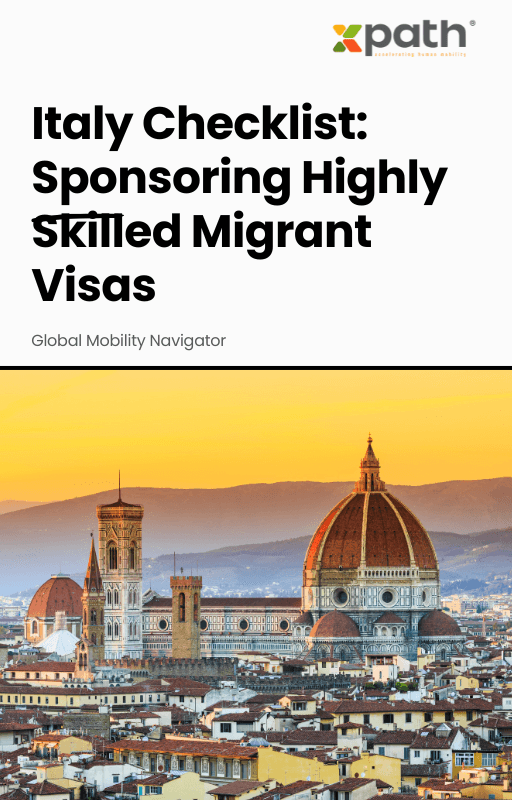Italy Checklist: Sponsoring Highly Skilled Migrant Visas
Grab a copy of a guide to international employee relocation
View E-bookMoving employees across borders is as much about managing dreams as it is about dodging compliance nightmares. With international assignments on the rise, ensuring seamless national insurance and payroll compliance for inbound assignees isn’t just a legal necessity—it’s the lifeline of modern global mobility. If you’re an HR leader, global mobility specialist, or finance professional tasked with overseeing the compliance maze, you know first-hand how intimidating it can be. Let’s break down today’s cross-border employment landscape, spotlight the challenges, and discover how smart solutions can make national insurance and payroll compliance almost effortless.
In a world where talent has no borders, companies are sending employees overseas more than ever before. According to Mercer’s 2023 Global Talent Trends report, 70% of multinational companies report increasing or intending to increase their international assignments in the coming three years. Inbound assignees—employees brought in from abroad to work in a host country—bring with them valuable perspectives and skills. But with opportunity comes obligation. National insurance (social security) and payroll compliance ensure assignees, organizations, and governments all stay on the right side of the law, pay the right contributions, and avoid penalties or missed benefits.
It’s astonishing how quickly one overlooked rule can cause a domino effect. Compliance is a moving target, heavily governed by local rules, international treaties, and, sometimes, by grey areas where clarity is elusive. For instance, the 2022 Worldwide Survey of International Assignment Policies & Practices by KPMG shows that 49% of organizations lost money due to payroll or social security non-compliance in the last two years, with many facing hefty fines, reputational damage, and employee dissatisfaction. So, if you think a small slip won’t hurt, think again—mistakes are costly, both in dollars and goodwill.
Here’s where the puzzle pieces get tricky. When an employee is assigned to work in a different country—let’s say an engineer from Brazil being posted to the UK—where should they pay social security? Do they contribute in their home country, their host country, or both? Social security agreements (like totalization agreements) between countries can provide clarity, but eligibility, duration, and processes vary widely.
Then comes payroll: taxes, reporting, withholdings, benefits—handled under vastly different regulatory environments. According to PwC’s 2023 Global Mobility Survey, 60% of organizations cited payroll complexity as the top compliance challenge. Not only do payroll systems need to satisfy local reporting obligations, but they also must adapt for multi-currency payments, variable cost-of-living adjustments, and benefits administration.
Let’s get real—compliance isn’t just an administrative headache. It keeps many HR leaders up at night. Why?
First, the pace of regulatory change is relentless. COVID-19, Brexit, and shifting global tax policies have altered the compliance landscape almost monthly in the past few years. For example, remote work agreements and “work from anywhere” models have blurred the lines of tax residency and social security affiliation.
Second, a lack of centralized guidance is notorious—especially for organizations managing multiple assignees in different regions. Case in point: In 2021, an Asian electronics company faced a $1 million penalty after overlooking social security registration deadlines for its EU-bound staff. Worse yet, employees risk losing access to public healthcare, pensions, or unemployment benefits if compliance slips.
Here’s the silver lining—digital transformation is rescuing organizations from the quicksand of manual compliance tracking. Cloud-based global mobility platforms, like xpath.global, offer a single source of truth with real-time dashboards, store and automate assignment documentation, and provide compliance alerts for every assignee in every location.
By integrating seamlessly with HRIS and payroll systems, platforms like xpath.global don’t just reduce the grunt work—they proactively spot potential red flags, automate calculations for multi-country payroll, and stay up to date with changing legislation. According to Deloitte’s 2023 Global Workforce Study, organizations using digital global mobility solutions reduce compliance errors by 35% and cut administrative time by up to 50%.
While there are several tools on the market, xpath.global stands out for its bespoke compliance workflows tailored to local rules, centralizing all compliance documentation, and offering direct support for both national insurance and payroll queries. It bridges the gap between HQ and local offices, reducing delays and manual errors. HR teams gain peace of mind, assignees get clarity, and companies build resilience and trust with every cross-border move.
With global assignments increasingly integral to business strategies, getting national insurance and payroll compliance right is critical. But you don’t have to go it alone. Empower your teams with the right insight, digital tools, and expertise—transforming compliance from a liability to a competitive advantage. Ready to future-proof your employee relocation game?
What is national insurance for inbound assignees?
National insurance (or social security) refers to mandatory contributions that fund public benefits such as healthcare and pensions. For inbound assignees, it means ensuring they are registered and contributing according to host-country laws—or under bilateral agreements—during their assignment.
How do payroll compliance requirements differ for assignees?
Payroll compliance can vary dramatically by country. Typical issues include calculating correct tax withholdings, accommodating different currencies, tracking bonuses, and factoring in cost-of-living allowances, all while reporting accurately to local authorities.
What happens if you miss a compliance deadline?
Penalties range from fines and back charges to losing the right to employ foreign workers. Employees could lose access to public healthcare or other benefits. A misstep can also disrupt visa status and company reputation.
How does xpath.global help with compliance?
xpath.global centralizes compliance documentation, automates key alerts, and integrates with payroll and HR systems. Its real-time dashboards and expert support enable organizations to stay ahead of local and international requirements.
Do all countries have the same requirements?
Absolutely not! Every country has its own rules on national insurance and payroll, plus bilateral agreements (or lack thereof) that affect contributions and eligibility for benefits.
Ready to transform your mobility program? Explore xpath.global’s solutions.

Italy Checklist: Sponsoring Highly Skilled Migrant Visas
Grab a copy of a guide to international employee relocation
View E-book